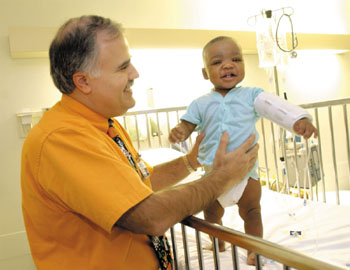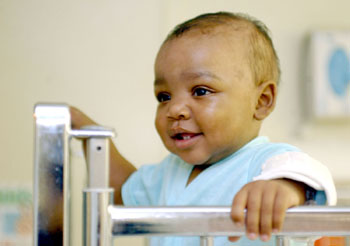
Dr. Haydar Frangoul visits Jaden Johnson in Vanderbilt Children's Hospital recently. Johnson was one of the first patients to receive a cord blood transplant at VCH. (photo by Dana Johnson)
VUMC cord blood procedure offers children viable option

Jaden Johnson is recovering well from a cord blood transplant he received last summer. (photo by Dana Johnson)
Bone marrow transplantation has been greatly refined since its development decades ago, resulting in better outcomes and fewer complications for patients.
Still, the biggest challenge — finding an appropriate donor — remains for many patients.
The Pediatric Stem Transplant Program at Vanderbilt Children’s Hospital and the Vanderbilt-Ingram Cancer Center has recently added a new service, umbilical cord blood transplant, that provides a critical option for children who cannot find a donor match in their family or through the National Bone Marrow Registry. This service is in addition to transplants from related and unrelated matched donors.
“The advantage is that with cord blood, you can get by with less perfect matching,” said Dr. Haydar Frangoul, assistant professor of Pediatrics and Medicine and director of the program. “This will be important for some children who reach the stage where they need a transplant and they have no match out of the five million in the registry. Without transplant, their chance of survival is very small.”
Bone marrow, or stem cell, transplant is used to treat a variety of diseases, most commonly leukemias and immune system deficiencies. The stem cells are immature cells produced in the spongy marrow in the hollows of the large bones. These cells are the precursors for all the cells of the blood — disease-fighting white cells, clotting platelets and oxygen-carrying red cells.
Chemotherapy and radiation are used to destroy the diseased bone marrow, and donor stem cells are then infused into the patient. As the bloodstream carries the new cells through the hollows of the bones, they recognize their “home,” collect and begin to grow. “It’s like me walking down the hall and knowing where my office is,” Frangoul explained.
Stem cells can be obtained from a donor’s marrow, typically drawn from within the pelvic bone, or from the bloodstream through a filtering process called apheresis. Stem cells are also found inside the umbilical cord that is typically thrown away at a child’s birth. These cells are particularly immature, which makes them more acceptable to the recipient’s body even without being a perfect or near-perfect match.
Cord blood transplantation will be particularly important for minority and mixed-race patients, whose ethnicities are underrepresented in the national registry, Frangoul said. Because the traits that must match to make a transplant successful are inherited, matches are much more likely within the same ethnic group.
In addition, umbilical cord blood is available for immediate use, compared to a search for a donor, which can take two months or more.
However, at this stage in its development, cord blood transplantation remains a last-resort option, Frangoul said, because it carries two distinct disadvantages:
• The volume of stem cells is much less than can be obtained from a donor. The typical cord blood unit contains 10 to 100 times fewer stem cells than a donation from an adult. With fewer stem cells available, the technique is only feasible for infants and small children. There are not enough stem cells to transplant an older child or adult.
• If the transplant fails or additional cells are needed, there is no source which to return.
Vanderbilt has performed cord blood transplants for four children, all under age three, since the program began earlier this year. Frangoul expects to perform four of five of the procedures annually.
In the meantime, Vanderbilt is participating in a multi-institutional study sponsored by the National Institutes of Health to validate the effectiveness of cord blood transplantation. Scientists elsewhere are working on methods to grow cord blood stem cells in the laboratory, which could make the option a viable one for adults and larger children.
Despite the utility of umbilical cord blood for transplantation, Frangoul concurs with the American Academy of Pediatrics position that parents should not pay to store their own infant’s cord blood in case that child needs it later.
“The likelihood that your child will develop leukemia is very small, and the likelihood that child will need a transplant is smaller still,” Frangoul said. And, he added, even if the child developed leukemia when he or she was small enough to potentially benefit from cord blood, the chances would be too great that the genetic defects that caused the leukemia were present in the cord blood.
Several cities, including New York and Seattle, have blood banks where umbilical cord blood can be donated. Thus far, there is no such bank in Tennessee.













